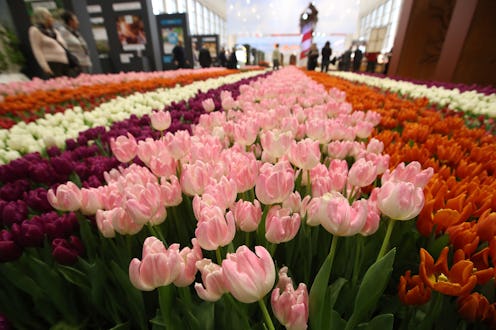Life
Red Roses Are Pretty Bad For The Environment — Here Are 5 Flowers To Give Your Boo Instead

They say a rose is a rose is a rose — but isn’t it also something else? We all know that a gift of red roses means something very different than a gift of yellow daisies or white carnations or even yellow rose. Human beings have been assigning meaning to flowers for ages; asking their delicate petals to carry much more weight than simple ornamentation.
“Flowers are one of the most obvious symbols of love and romance, especially with examples like the classic red rose and the plush pink peony,” Claire Larkin, language expert at language learning app Babbel, tells Bustle. “No Valentine’s Day would be complete without their appearance.”
But where do those meanings come from? They’re certainly not universal. For example, a bride in the United States may choose to have white roses in their bouquet, but in China they’re used for funerals. And while much of the meaning behind flowers comes from the meaning each culture assigns to certain colors, there are other influences as well.
“While floral symbology has been around for centuries, most current associations with flowers can be traced back to the Victorian Era’s obsession with floriography, or ‘the language of flowers,’” Larkin says. “The Victorian upper class and bourgeoisie, engrossed with aesthetics and left with too much time on their hands, developed an intricate system of secret meanings for flowers. Floral arrangements were no longer just something nice to look at, but a means to deliver discreet messages.”
So what kind of message are you sending this Valentine’s Day? As Larkin notes, many people feel that Valentine’s Day wouldn’t be complete without red roses. And the numbers back that up: According to an investigation by Vox, Americans will spend $2 billion on red roses this Valentine’s Day. The same investigation found that the flower industry contributes greatly to climate change, both by flying flowers from South America and by transporting them across the United States in refrigerated trucks.
If the message you want to send is “I’m into you — but not so into climate change,” it might be worth it to consider a more sustainable flower option for Valentine’s Day this year. That means shopping for flowers locally, which means your pretty blooms aren’t being shipped across land and ocean to get to you. If you’re not sure where to get local flowers in your area, Vox recommends checking out the Slow Flowers’ website, which is a directory of more than 700 growers in the US and Canada who offer local blooms. Combine that resource with this list of five flowers that are in season on Valentine’s Day, the regions you can find them, and what they symbolize for a more environmentally friendly Valentine's Day.
1Red Tulips: Mountain States, Mid-Atlantic, West Coast, Northeast, Southeast
Red tulips symbolize “perfect love," according to the Victorians. And, lucky enough, they’re available in quite a few regions for Valentine’s Day. If you live in any of these regions, how your boo just how great you think they are by choosing from one of these florists.
2Red Chrysanthemums: West Coast
If you want to say a straightforward “I love you” but also want your bouquet to stand out from the slew of Valentine’s Day blooms, go for an arrangement of red chrysanthemums. West Coasters can find them this time of year and rest assured that their bouquets are environmentally friendly.
3Red Roses: West Coast
Not everyone has to eschew the classic symbol of love! If you’re on the West Coast, a local florist can get them to you with a dramatically lower impact on the environment.
4Red Carnations: Most Places
“Nowadays the carnation is a classic symbol of love and romance,” Larkin says. “Its vivid petals are a mainstay in Valentine’s Day arrangements, right after the classic red rose. This association goes back at least until the Renaissance, where wealthy young women were often painted holding carnations to symbolize a recent engagement.”
Carnations that you find at the florist are usually grown in a greenhouse, which means you can find them in a range of locations. It’s worth checking with your local florist to see if they have some — and double-checking where they came from.
5Orchid: Hawaii
“With its unique exotic form, the orchid often invokes associations with sensuality and sexuality in modern culture,” Larkin says. “It should be no surprise to hear, then, that the word ‘orchid’ comes from the Ancient Greek word orchis, meaning ‘testicle.’ This association likely originates from the shape of the bulbous roots, which the Ancient Greeks thought symbolized virility. This symbolism was so strong that a man in this society would eat an orchid with large roots in order to supposedly increase his chances of having a male child.” Unlike people on the mainland U.S., Hawaiians can grab these exotic beauties at local florists in February.
For the rest of you, find your region, get to that locally grown florist, and make the choice to be kinder to the environment this Valentine's Day.